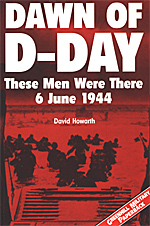 Greenhill Books, 2001, £ 11.99, ISBN: 1-85367-439-7, 255 pgs trade soft cover
Greenhill Books, 2001, £ 11.99, ISBN: 1-85367-439-7, 255 pgs trade soft cover
Originally published in 1959, this Greenhill reprint follows a few dozen or so soldiers and sailors--on both sides of the front line--during that fateful day in June 1944. It only provides passing mention of grand strategies or operational analysis, and doesn't offer orders of battle or maps with arrows on them. Instead, the focus is on the life and death struggles of US, British, Canadian, Norwegian, and German troops during the invasion.
Howarth writes a good book akin to technothriller fiction, except these stories (some interwoven with others, but most standing alone) are real. US and UK accounts predominate as horros and courage coincide from the airdrops to the landings. You feel incredibly close at hand as each vignette plays out: Sgt.-Major H.W. Bowers' attack across the beach towards a pillbox, Capt. George Mowbray's assault and eventual link-up with the paratroopers, Commander Joseph H. Gibbons' efforts to blow up the obstacles on Omaha beach so more troops and tanks can land--even as troops shelter behind these obstacles.
Here's a bit from Bowers' escapade:
- In the gap he met two sailors of the R.N. Commandos. They had been with him on the landing craft, and he knew them as Paddy and Taffy. "Hey, Harry," they shouted. "Where are you going? Can we come and have a bit of fun?"
"Some people have a queer idea of fun," he said, glad of their company and of their tommy guns.
The three men worked their way across the devastated space behind the seawall, fighting it out with some Germans who threatened to take them in the rear, and won a position behind the pillbox, close to the ruins of the sanatorium. A grenade was thrown at them there. It rolled along the ground, rolled so long that Bowers shouted "All right, it's a dud," whereupon it exploded and wounded Paddy in the leg. The others patched him up.
Bowers put the two sailors in a position to cover the pillbox with their tommy guns, because he had spotted a way to get to grips with it. They poured a continuous fire at the openings they could see, and under the protection of their fire he climbed into the ruins, and through them, and found an empty window above the pillbox and jumped down on to the roof of it. He ran across the roof, and lay down on his stomach and leaned over the edge with a grenade in his hand. Through the firing slit below him, somebody was pushing a white sheet of surrender, but he thought "Hell with you, mate, after all this trouble," and he dropped his grenade through the slit.
After the explosion, the door of the pillbox was opened and the survivors ran out. They had their hands up. From his perch on the roof, he looked down at them with interest, partly because they seemed to be shouting that they were Russian, and also because some of them were wearing nice soft German army boots. [p. 188]
One of the best concerns German Captain Heinrich Hoffmann, in command of three torpedo boats mounting an attack upon the entire invasion force, and Norwegian Capt. Tore Holthe, in charge of the Destroyer Svenner. Here, German daring runs up against Norwegian bad luck that day as Hoffmann burst through a smokescreen and fired 17 torpedos. Only one hit, but it was sufficient to sink the Svenner. The bad luck part is that the Svenner was hit on the port side, which was facing the invasion fleet, and not the port side, which was facing the open sea. Hoffmann's torpedos, fired at a relatively close-packed invasion fleet, missed all targets except the one. The torpoedo had travelled through the invasion fleet to hit the Norwegian ship. Howarth's retelling of this anecdote is an inspired piece of prose.
If Saving Private Ryan did anuthing, it poured D-Day back into public consciousness. Dawn of D-Day will cement it in place.
Info: Greenhill:
E-mail for more information
www.greenhillbooks.com
Back to List of Book Reviews: World War II
Back to Master List of Book Reviews
Back to Master Magazine List
© Copyright 2001 by Coalition Web, Inc.
This article appears in MagWeb (Magazine Web) on the Internet World Wide Web.
Other military history articles and gaming articles are available at http://www.magweb.com